The Role of Artificial Intelligence in Sustainable Ocean Waste Tracking and Management: A Bibliometric Analysis
Abstract
1. Introduction
2. Methodology
2.1. Database Selection
2.2. Data Collection
3. Bibliometric Analysis Results
3.1. Publications by Year
3.2. Journals of Publication
3.3. Main Research Area
3.3.1. What Are the Main Research Areas in AI-Driven Ocean Waste Tracking and Management?
3.3.2. The 20 Most Studied Subject Areas
3.3.3. Co-Occurrence Analysis of Keywords
3.4. Publications by Institutions
- ▪ United States: The Universal Village Society and the University of Minnesota dominate the United States;
- ▪ China: Multiple institutions, such as South China University of Technology, Shenzhen University, and Hangzhou Dianzi University, actively contribute publications;
- ▪ Australia: The University of Adelaide;
- ▪ United Kingdom: Warwick Manufacturing Group, University of Warwick;
- ▪ Singapore: Singapore Institute of Manufacturing Technology;
- ▪ Germany: Friedrich–Alexander University Erlangen–Nürnberg.
3.5. Countries of Top Publications
3.6. Citation Analysis of Cited Journals
3.7. H-Index Analysis of the Cited Journals
3.8. Co-Citation Analysis of Authors
3.9. Bibliographic Coupling
4. Emerging Trends
5. In-Depth Analysis of Key Literature
5.1. AI Applications in Ocean Waste Tracking and Management
5.2. Challenges and Limitations of AI in Ocean Waste Tracking and Management
5.3. Limitations of the Methodologies Applied
6. Conclusions
Funding
Conflicts of Interest
References
- Fleming, L.E.; Maycock, B.; White, M.P.; Depledge, M.H. Fostering human health through ocean sustainability in the 21st century. People Nat. 2019, 1, 276–283. [Google Scholar] [CrossRef]
- Battisti, C.; Poeta, G.; Romiti, F.; Picciolo, L. Small environmental actions need a problem-solving approach: Applying project management tools to beach litter clean-ups. Environments 2020, 7, 87. [Google Scholar] [CrossRef]
- Schmaltz, E.; Melvin, E.C.; Diana, Z.; Gunady, E.F.; Rittschof, D.; Somarelli, J.A.; Virdin, J.; Dunphy-Daly, M.M. Plastic pollution solutions: Emerging technologies to prevent and collect marine plastic pollution. Environ. Int. 2020, 144, 106067. [Google Scholar] [CrossRef] [PubMed]
- Sharma, H.B.; Vanapalli, K.R.; Samal, B.; Cheela, V.S.; Dubey, B.K.; Bhattacharya, J. Circular economy approach in solid waste management system to achieve UN-SDGs: Solutions for post-COVID recovery. Sci. Total Environ. 2021, 800, 149605. [Google Scholar] [CrossRef]
- Winterstetter, A.; Grodent, M.; Kini, V.; Ragaert, K.; Vrancken, K.C. A review of technological solutions to prevent or reduce marine plastic litter in developing countries. Sustainability 2021, 13, 4894. [Google Scholar] [CrossRef]
- Ditria, E.M.; Buelow, C.A.; Gonzalez-Rivero, M.; Connolly, R.M. Artificial intelligence and automated monitoring for assisting conservation of marine ecosystems: A perspective. Front. Mar. Sci. 2022, 9, 918104. [Google Scholar] [CrossRef]
- Altowayti, W.A.H.; Shahir, S.; Othman, N.; Eisa, T.A.E.; Yafooz, W.M.S.; Al-Dhaqm, A.; Soon, C.Y.; Yahya, I.B.; Rahim, N.A.N.B.C.; Abaker, M.; et al. The role of conventional methods and artificial intelligence in the wastewater treatment: A comprehensive review. Processes 2022, 10, 1832. [Google Scholar] [CrossRef]
- Gambin, A.F.; Angelats, E.; Gonzalez, J.S.; Miozzo, M.; Dini, P. Sustainable marine ecosystems: Deep learning for water quality assessment and forecasting. IEEE Access 2021, 9, 121344–121365. [Google Scholar] [CrossRef]
- El Mahrad, B.; Newton, A.; Icely, J.D.; Kacimi, I.; Abalansa, S.; Snoussi, M. Contribution of remote sensing technologies to a holistic coastal and marine environmental management framework: A review. Remote Sens. 2020, 12, 2313. [Google Scholar] [CrossRef]
- Glaviano, F.; Esposito, R.; Di Cosmo, A.; Esposito, F.; Gerevini, L.; Ria, A.; Molinara, M.; Bruschi, P.; Costantini, M.; Zupo, V. Management and sustainable exploitation of marine environments through smart monitoring and automation. J. Mar. Sci. Eng. 2022, 10, 297. [Google Scholar] [CrossRef]
- Bhatia, S.; Bansal, D.; Patil, S.; Pandya, S.; Ilyas, Q.M.; Imran, S. A retrospective study of climate change affecting dengue: Evidences, challenges and future directions. Front. Public Health 2022, 10, 884645. [Google Scholar] [CrossRef]
- Kaandorp, M.L.A.; Ypma, S.L.; Boonstra, M.; Dijkstra, H.A.; van Sebille, E. Using machine learning and beach cleanup data to explain litter quantities along the Dutch North Sea coast. Ocean Sci. 2022, 18, 269–293. [Google Scholar] [CrossRef]
- Kostas, E.T.; Adams, J.M.; Ruiz, H.A.; Durán-Jiménez, G.; Lye, G.J. Macroalgal biorefinery concepts for the circular bioeconomy: A review on biotechnological developments and future perspectives. Renew. Sustain. Energy Rev. 2021, 151, 111553. [Google Scholar] [CrossRef]
- Ganesapillai, M.; Mondal, B.; Sarkar, I.; Sinha, A.; Ray, S.S.; Kwon, Y.-N.; Nakamura, K.; Govardhan, K. The face behind the COVID-19 mask—A comprehensive review. Environ. Technol. Innov. 2022, 28, 102837. [Google Scholar] [CrossRef]
- Trice, A.T.; Robbins, C.R.; Philip, N.P.; Rumsey, M.R. Challenges and Opportunities for Ocean Data to Advance Conservation and Management; Ocean Conservancy: Washington, DC, USA, 2021. [Google Scholar] [CrossRef]
- Himeur, Y.; Rimal, B.; Tiwary, A.; Amira, A. Using artificial intelligence and data fusion for environmental monitoring: A review and future perspectives. Inf. Fusion 2022, 86–87, 44–75. [Google Scholar] [CrossRef]
- Nishant, R.; Kennedy, M.; Corbett, J. Artificial intelligence for sustainability: Challenges, opportunities, and a research agenda. Int. J. Inf. Manag. 2020, 53, 102104. [Google Scholar] [CrossRef]
- D’amico, G.; Szopik-Depczyńska, K.; Dembińska, I.; Ioppolo, G. Smart and sustainable logistics of Port cities: A framework for comprehending enabling factors, domains and goals. Sustain. Cities Soc. 2021, 69, 102801. [Google Scholar] [CrossRef]
- Isabelle, D.A.; Westerlund, M. A review and categorization of artificial intelligence-based opportunities in wildlife, ocean and land conservation. Sustainability 2022, 14, 1979. [Google Scholar] [CrossRef]
- Mustafa, S.; Estim, A.; Tuzan, A.D.; Ann, C.C.; Seng, L.L.; Shaleh, S.R.M. Nature-based and technology-based solutions for sustainable blue growth and climate change mitigation in marine biodiversity hotspots. Environ. Biotechnol. 2019, 15, 1–7. [Google Scholar] [CrossRef]
- Pessin, V.Z.; Yamane, L.H.; Siman, R.R. Smart bibliometrics: An integrated method of science mapping and bibliometric analysis. Scientometrics 2022, 127, 3695–3718. [Google Scholar] [CrossRef]
- Bibri, S.E. Data-driven smart sustainable cities of the future: An evidence synthesis approach to a comprehensive state-of-the-art literature review. Sustain. Futur. 2021, 3, 100047. [Google Scholar] [CrossRef]
- Secundo, G.; Ndou, V.; Del Vecchio, P.; De Pascale, G. Sustainable development, intellectual capital and technology policies: A structured literature review and future research agenda. Technol. Forecast. Soc. Chang. 2020, 153, 119917. [Google Scholar] [CrossRef]
- Wohlin, C.; Kalinowski, M.; Felizardo, K.R.; Mendes, E. Successful combination of database search and snowballing for identification of primary studies in systematic literature studies. Inf. Softw. Technol. 2022, 147, 106908. [Google Scholar] [CrossRef]
- Zhang, Y.; Wang, X.; Sun, L.; Lei, P.; Chen, J.; He, J.; Zhou, Y.; Liu, Y. Mask-guided deep learning fishing net detection and recognition based on underwater range gated laser imaging. Opt. Laser Technol. 2024, 171, 110402. [Google Scholar] [CrossRef]
- Wang, B.; Yao, X.; Yang, M.; Zhang, R.; Huang, J.; Wang, X.; Dong, Z.; Zhao, H. Mechanical performance of 3D printed concrete in steam curing conditions. Materials 2022, 15, 2864. [Google Scholar] [CrossRef]
- Huda, F.R.; Richard, F.S.; Rahman, I.; Moradi, S.; Hua, C.T.Y.; Wanwen, C.A.S.; Fong, T.L.; Mujahid, A.; Müller, M. Comparison of learning models to predict LDPE, PET, and ABS concentrations in beach sediment based on spectral reflectance. Sci. Rep. 2023, 13, 6258. [Google Scholar] [CrossRef] [PubMed]
- Rußwurm, M.; Venkatesa, S.J.; Tuia, D. Large-scale detection of marine debris in coastal areas with Sentinel-2. iScience 2023, 26, 108402. [Google Scholar] [CrossRef]
- Yang, B.-C.; Zhao, Y.; Yao, T.-Y.; Zhou, Y.-J.; Jia, M.-Y.; Hu, H.-Y.; Xiao, C.-C. Summary of research on highway bridge vehicle force identification. Sustainability 2024, 16, 4469. [Google Scholar] [CrossRef]
- Chen, Q.; Yang, Y.; Qi, H.; Su, L.; Zuo, C.; Shen, X.; Chu, W.; Li, F.; Shi, H. Rapid Mass Conversion for Environmental Microplastics of Diverse Shapes. Environ. Sci. Technol. 2024, 58, 10776–10785. [Google Scholar] [CrossRef]
- Martynova, A.; Rodrigue, M.; Pieribone, V.; Qurban, M.; Duarte, C.M. Density and distribution patterns of seafloor macrolitter in the eastern Red Sea. Sci. Total Environ. 2024, 953, 176042. [Google Scholar] [CrossRef]
- Pellegrini, C.; Saliu, F.; Bosman, A.; Sammartino, I.; Raguso, C.; Mercorella, A.; Galvez, D.; Petrizzo, A.; Madricardo, F.; Lasagni, M.; et al. Hotspots of microplastic accumulation at the land-sea transition and their spatial heterogeneity: The Po River prodelta (Adriatic Sea). Sci. Total Environ. 2023, 895, 164908. [Google Scholar] [CrossRef] [PubMed]
- Sozio, A.; Scarrica, V.M.; Rizzo, A.; Aucelli, P.P.C.; Barracane, G.; Dimuccio, L.A.; Ferreira, R.; La Salandra, M.; Staiano, A.; Tarantino, M.P.; et al. Application of Direct and Indirect Methodologies for Beach Litter Detection in Coastal Environments. Remote Sens. 2024, 16, 3617. [Google Scholar] [CrossRef]
- Wang, R.; Record, N.R.; King, D.W.; Chowdhury, T. Designing A Sustainable Marine Debris Clean-up Framework without Human Labels. In Proceedings of the 7th ACM SIGCAS/SIGCHI Conference on Computing and Sustainable Societies, New Delhi, India, 8–11 July 2024. [Google Scholar] [CrossRef]
- Castano-Londono, L.; Llorente, S.d.P.M.; Paipa-Sanabria, E.; Orozco-Lopez, M.B.; Montaña, D.I.F.; Montoya, D.G. Evolution of Algorithms and Applications for Unmanned Surface Vehicles in the Context of Small Craft: A Systematic Review. Appl. Sci. 2024, 14, 9693. [Google Scholar] [CrossRef]
- Su, L.; Dong, X.; Peng, J.; Cheng, H.; Craig, N.J.; Hu, B.; Li, J.-Y. Segmentation of beach plastic fragments’ contours based on self-organizing map and multi-shape descriptors: A rapid indication of fragmentation and wearing types. J. Hazard. Mater. 2024, 478, 135564. [Google Scholar] [CrossRef]
- Xie, H.; Zhang, Y.; Wu, Z.; Lv, T. A bibliometric analysis on land degradation: Current status, development, and future directions. Land 2020, 9, 28. [Google Scholar] [CrossRef]
- Baker, H.K.; Pandey, N.; Kumar, S.; Haldar, A. A bibliometric analysis of board diversity: Current status, development, and future research directions. J. Bus. Res. 2020, 108, 232–246. [Google Scholar] [CrossRef]
- Park, Y.E. A data-driven approach for discovery of the latest research trends in higher education for business by leveraging advanced technology and big data. J. Educ. Bus. 2021, 96, 291–298. [Google Scholar] [CrossRef]
- Agostini, L.; Nosella, A.; Sarala, R.; Spender, J.C.; Wegner, D. Tracing the evolution of the literature on knowledge management in inter-organizational contexts: A bibliometric analysis. J. Knowl. Manag. 2020, 24, 463–490. [Google Scholar] [CrossRef]
- Hoang, T.D.; Ky, N.M.; Thuong, N.T.N.; Nhan, H.Q.; Ngan, N.V.C. Artificial intelligence in pollution control and management: Status and future prospects. In Artificial Intelligence and Environmental Sustainability: Challenges and Solutions in the Era of Industry 4.0; Springer: Singapore, 2022; pp. 23–43. [Google Scholar]
- Mustapha, U.F.; Alhassan, A.; Jiang, D.; Li, G. Sustainable aquaculture development: A review on the roles of cloud computing, internet of things and artificial intelligence (CIA). Rev. Aquac. 2021, 13, 2076–2091. [Google Scholar] [CrossRef]
- Mumtaz, N.; Izhar, T.; Pandey, G.; Labhasetwar, P.K. Utilizing artificial intelligence for environmental sustainability. In Artificial Intelligence for Renewable Energy Systems; Woodhead Publishing: Sawston, UK, 2022; pp. 259–279. [Google Scholar] [CrossRef]
- Shahab, S.; Anjum, M. Solid waste management scenario in india and illegal dump detection using deep learning: An AI approach towards the sustainable waste management. Sustainability 2022, 14, 15896. [Google Scholar] [CrossRef]
- Tahmasebi, P.; Kamrava, S.; Bai, T.; Sahimi, M. Machine learning in geo-and environmental sciences: From small to large scale. Adv. Water Resour. 2020, 142, 103619. [Google Scholar] [CrossRef]
- Mahmoud, A.E.D.; Desokey, O. Artificial intelligence-based smart waste management for the circular economy. In Environmental Management Technologies; CRC Press: Boca Raton, FL, USA, 2022; pp. 341–358. [Google Scholar] [CrossRef]
- Kumar, R.; Verma, A.; Shome, A.; Sinha, R.; Sinha, S.; Jha, P.K.; Kumar, R.; Kumar, P.; Shubham; Das, S.; et al. Impacts of plastic pollution on ecosystem services, sustainable development goals, and need to focus on circular economy and policy interventions. Sustainability 2021, 13, 9963. [Google Scholar] [CrossRef]
- Fahlevi, M. A Systematic Literature Review on Marine Tourism in Business Management: State of the Art and Future Research Agenda. J. Tour. Serv. 2023, 14, 299–321. [Google Scholar] [CrossRef]
- Filom, S.; Amiri, A.M.; Razavi, S. Applications of machine learning methods in port operations—A systematic literature review. Transp. Res. Part E Logist. Transp. Rev. 2022, 161, 102722. [Google Scholar] [CrossRef]
- Zhang, A.; Venkatesh, V.; Liu, Y.; Wan, M.; Qu, T.; Huisingh, D. Barriers to smart waste management for a circular economy in China. J. Clean. Prod. 2019, 240, 118198. [Google Scholar] [CrossRef]
- Gupta, P.K.; Saxena, A.; Dattaprakash, B.; Sheriff, R.S.; Chaudhari, S.H.; Ullanat, V.; Chayapathy, V. Applications of Artificial Intelligence in Environmental Science. In Artificial Intelligence (AI); CRC Press: Boca Raton, FL, USA, 2021; pp. 225–240. [Google Scholar]
- Dwivedi, Y.K.; Hughes, L.; Kar, A.K.; Baabdullah, A.M.; Grover, P.; Abbas, R.; Andreini, D.; Abumoghli, I.; Barlette, Y.; Bunker, D.; et al. Climate change and COP26: Are digital technologies and information management part of the problem or the solution? An editorial reflection and call to action. Int. J. Inf. Manag. 2022, 63, 102456. [Google Scholar] [CrossRef]
- Maximenko, N.; Corradi, P.; Law, K.L.; Van Sebille, E.; Garaba, S.P.; Lampitt, R.S.; Galgani, F.; Martinez-Vicente, V.; Goddijn-Murphy, L.; Veiga, J.M.; et al. Toward the integrated marine debris observing system. Front. Mar. Sci. 2019, 6, 447. [Google Scholar] [CrossRef]
- Kieu, H.T.; Law, A.W.-K. Remote sensing of coastal hydro-environment with portable unmanned aerial vehicles (pUAVs) a state-of-the-art review. J. Hydro-Environ. Res. 2021, 37, 32–45. [Google Scholar] [CrossRef]
- Gladju, J.; Kamalam, B.S.; Kanagaraj, A. Applications of data mining and machine learning framework in aquaculture and fisheries: A review. Smart Agric. Technol. 2022, 2, 100061. [Google Scholar] [CrossRef]
- Saad, A.; Stahl, A.; Våge, A.; Davies, E.; Nordam, T.; Aberle, N.; Ludvigsen, M.; Johnsen, G.; Sousa, J.; et al.; Norwegian University of Science and Technology Advancing ocean observation with an ai-driven mobile robotic explorer. Oceanography 2020, 33, 50–59. [Google Scholar] [CrossRef]
- Bakker, K. Smart Oceans: Artificial intelligence and marine protected area governance. Earth Syst. Gov. 2022, 13, 100141. [Google Scholar] [CrossRef]
- Melet, A.; Teatini, P.; Le Cozannet, G.; Jamet, C.; Conversi, A.; Benveniste, J.; Almar, R. Earth observations for monitoring marine coastal hazards and their drivers. Surv. Geophys. 2020, 41, 1489–1534. [Google Scholar] [CrossRef]
- Fallati, L.; Polidori, A.; Salvatore, C.; Saponari, L.; Savini, A.; Galli, P. Anthropogenic Marine Debris assessment with Unmanned Aerial Vehicle imagery and deep learning: A case study along the beaches of the Republic of Maldives. Sci. Total Environ. 2019, 693, 133581. [Google Scholar] [CrossRef]
- Kim, T.; Lee, W.-D. Review on applications of machine learning in coastal and ocean engineering. J. Ocean Eng. Technol. 2022, 36, 194–210. [Google Scholar] [CrossRef]
- Kuznetsova, E.; Cardin, M.A.; Diao, M.; Zhang, S. Integrated decision-support methodology for combined centralized-decentralized waste-to-energy management systems design. Renew. Sustain. Energy Rev. 2019, 103, 477–500. [Google Scholar] [CrossRef]
- Benitez-Bravo, R.; Gomez-González, R.; Rivas-García, P.; Botello-Álvarez, J.E.; Huerta-Guevara, O.F.; García-León, A.M.; Rueda-Avellaneda, J.F. Optimization of municipal solid waste collection routes in a Latin-American context. J. Air Waste Manag. Assoc. 2021, 71, 1415–1427. [Google Scholar] [CrossRef]
- Whitt, C.; Pearlman, J.; Polagye, B.; Caimi, F.; Muller-Karger, F.; Copping, A.; Spence, H.; Madhusudhana, S.; Kirkwood, W.; Grosjean, L.; et al. Future vision for autonomous ocean observations. Front. Mar. Sci. 2020, 7, 697. [Google Scholar] [CrossRef]
- Zuzanna, K.; Tomasz, U.; Michal, G.; Robert, P. How high-tech solutions support the fight against IUU and ghost fishing: A review of innovative approaches, methods, and trends. IEEE Access 2022, 10, 112539–112554. [Google Scholar] [CrossRef]
- Das, S.; Lee, S.-H.; Kumar, P.; Kim, K.-H.; Lee, S.S.; Bhattacharya, S.S. Solid waste management: Scope and the challenge of sustainability. J. Clean. Prod. 2019, 228, 658–678. [Google Scholar] [CrossRef]
- Wei, Y.; Wei, Q.; An, D. Intelligent monitoring and control technologies of open sea cage culture: A review. Comput. Electron. Agric. 2020, 169, 105119. [Google Scholar] [CrossRef]
- Ali, H.; Khattak, W.A. Big Data for Sustainability: A Holistic Approach to Environmental Conservation and Resource Management. J. Big-Data Anal. Cloud Comput. 2022, 7, 18–30. [Google Scholar]
- Sequeira, A.M.M.; Hays, G.C.; Sims, D.W.; Eguíluz, V.M.; Rodríguez, J.P.; Heupel, M.R.; Harcourt, R.; Calich, H.; Queiroz, N.; Costa, D.P.; et al. Overhauling ocean spatial planning to improve marine megafauna conservation. Front. Mar. Sci. 2019, 6, 639. [Google Scholar] [CrossRef]
- Deekshith, A. Cross-Disciplinary Approaches: The Role of Data Science in Developing AI-Driven Solutions for Business Intelligence. arXiv 2022, arXiv:2012.07906. [Google Scholar]
- Soomro, K.; Bhutta, M.N.M.; Khan, Z.; Tahir, M.A. Smart city big data analytics: An advanced review. Wiley Interdiscip. Rev. Data Min. Knowl. Discov. 2019, 9, e1319. [Google Scholar] [CrossRef]
- Cheah, C.G.; Chia, W.Y.; Lai, S.F.; Chew, K.W.; Chia, S.R.; Show, P.L. Innovation designs of industry 4.0 based solid waste management: Machinery and digital circular economy. Environ. Res. 2022, 213, 113619. [Google Scholar] [CrossRef]
- Maiurova, A.; Kurniawan, T.A.; Kustikova, M.; Bykovskaia, E.; Othman, M.H.D.; Singh, D.; Goh, H.H. Promoting digital transformation in waste collection service and waste recycling in Moscow (Russia): Applying a circular economy paradigm to mitigate climate change impacts on the environment. J. Clean. Prod. 2022, 354, 131604. [Google Scholar] [CrossRef]
- Richards, C.E.; Tzachor, A.; Avin, S.; Fenner, R. Rewards, risks and responsible deployment of artificial intelligence in water systems. Nat. Water 2023, 1, 422–432. [Google Scholar] [CrossRef]
- Sun, A.Y.; Scanlon, B.R. How can Big Data and machine learning benefit environment and water management: A survey of methods, applications, and future directions. Environ. Res. Lett. 2019, 14, 073001. [Google Scholar] [CrossRef]
- Amani, M.; Mehravar, S.; Asiyabi, R.M.; Moghimi, A.; Ghorbanian, A.; Ahmadi, S.A.; Ebrahimy, H.; Moghaddam, S.H.A.; Naboureh, A.; Ranjgar, B.; et al. Ocean remote sensing techniques and applications: A review (part ii). Water 2022, 14, 3401. [Google Scholar] [CrossRef]
- Galaz, V.; Centeno, M.A.; Callahan, P.W.; Causevic, A.; Patterson, T.; Brass, I.; Baum, S.; Farber, D.; Fischer, J.; Garcia, D.; et al. Artificial intelligence, systemic risks, and sustainability. Technol. Soc. 2021, 67, 101741. [Google Scholar] [CrossRef]
- Ahmad, T.; Zhang, D.; Huang, C.; Zhang, H.; Dai, N.; Song, Y.; Chen, H. Artificial intelligence in sustainable energy industry: Status Quo, challenges and opportunities. J. Clean. Prod. 2021, 289, 125834. [Google Scholar] [CrossRef]
- Molina-Molina, J.C.; Salhaoui, M.; Guerrero-González, A.; Arioua, M. Autonomous marine robot based on AI recognition for permanent surveillance in marine protected areas. Sensors 2021, 21, 2664. [Google Scholar] [CrossRef] [PubMed]
- Malde, K.; Handegard, N.O.; Eikvil, L.; Salberg, A.-B. Machine intelligence and the data-driven future of marine science. ICES J. Mar. Sci. 2020, 77, 1274–1285. [Google Scholar] [CrossRef]
- Jain, S.; Ahuja, N.J.; Srikanth, P.; Bhadane, K.V.; Nagaiah, B.; Kumar, A.; Konstantinou, C. Blockchain and autonomous vehicles: Recent advances and future directions. IEEE Access 2021, 9, 130264–130328. [Google Scholar] [CrossRef]
- Adusei-Gyamfi, J.; Boateng, K.S.; Sulemana, A.; Hogarh, J.N. Post COVID-19 recovery: Challenges and opportunities for solid waste management in Africa. Environ. Chall. 2022, 6, 100442. [Google Scholar] [CrossRef]


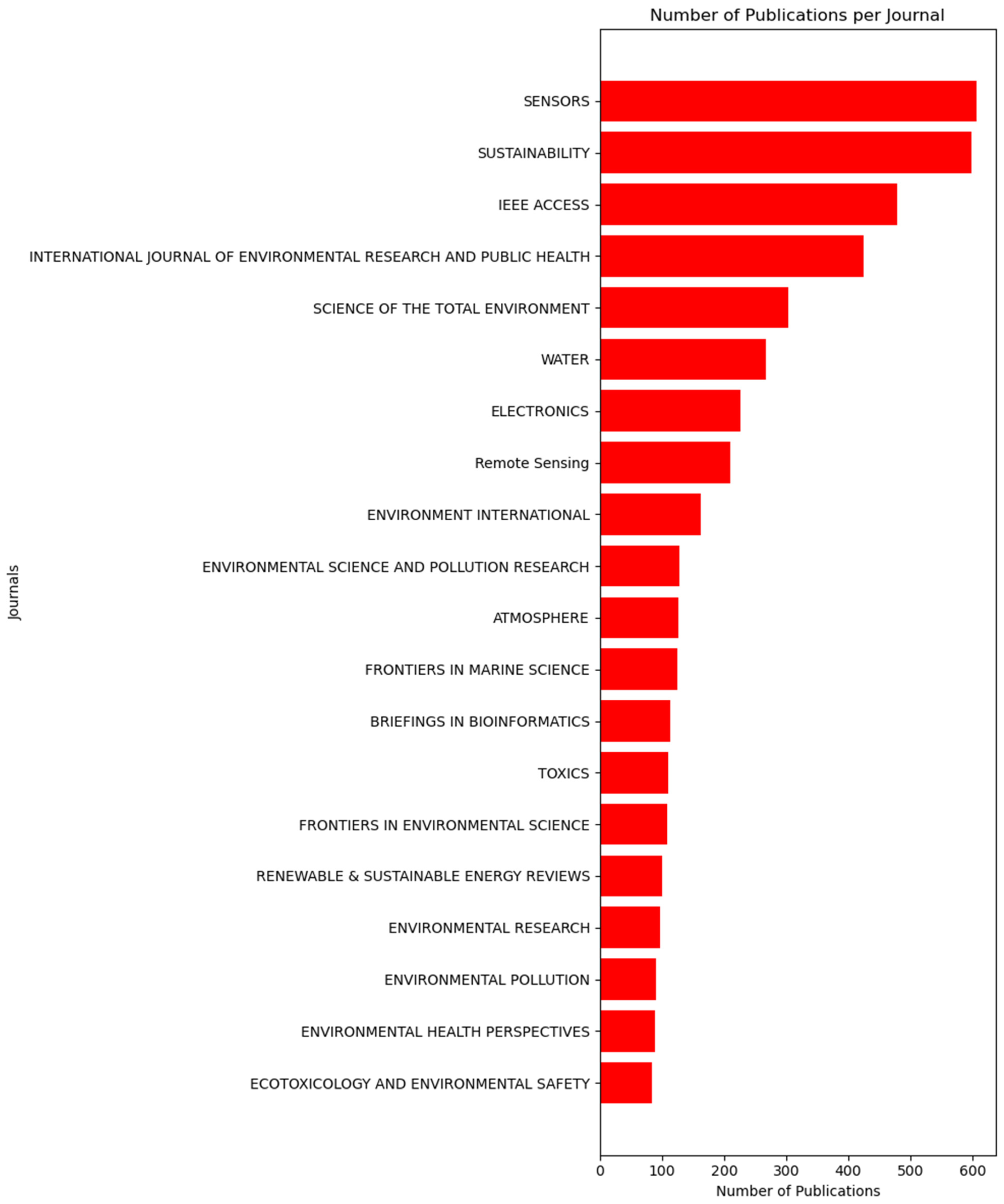
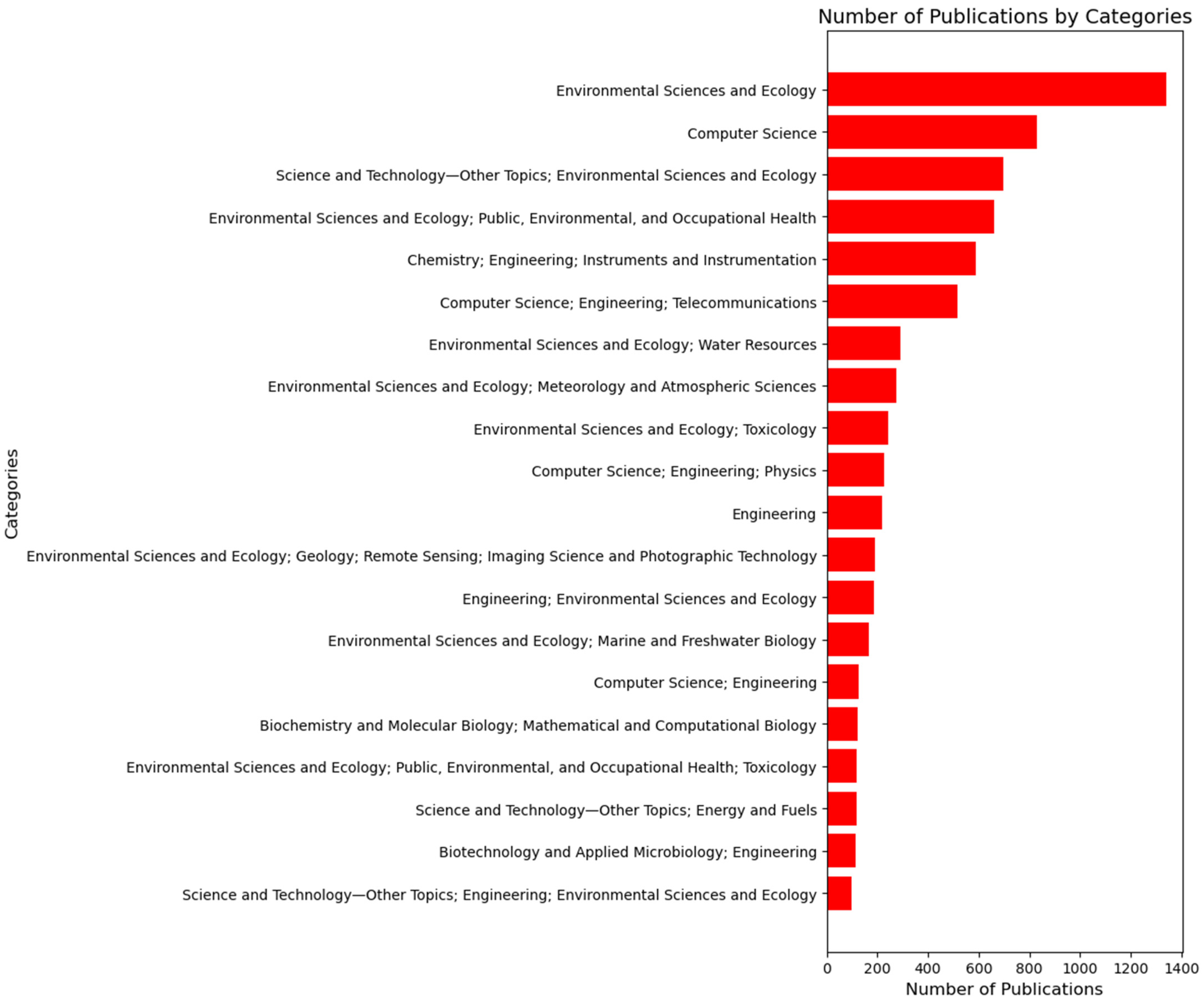
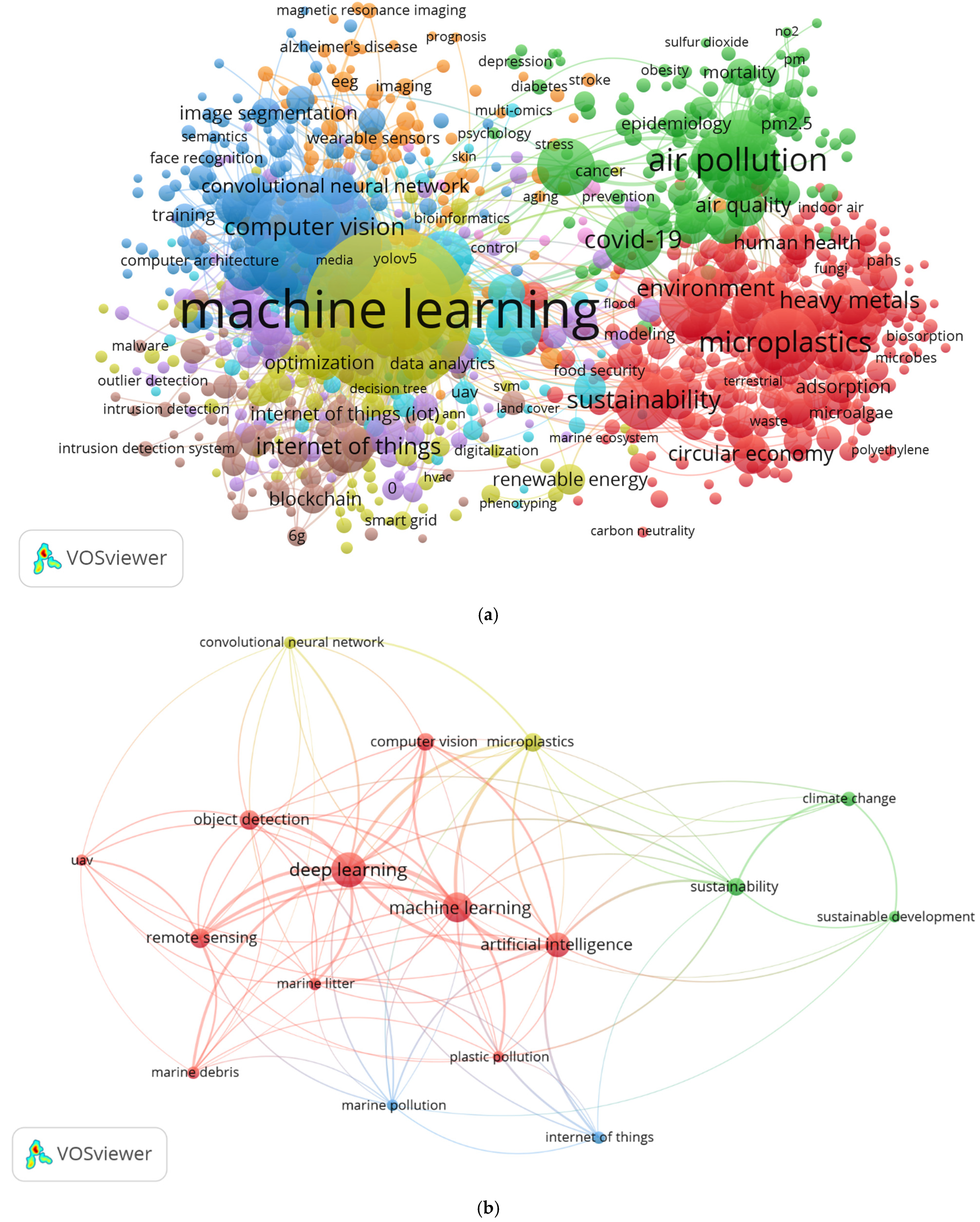

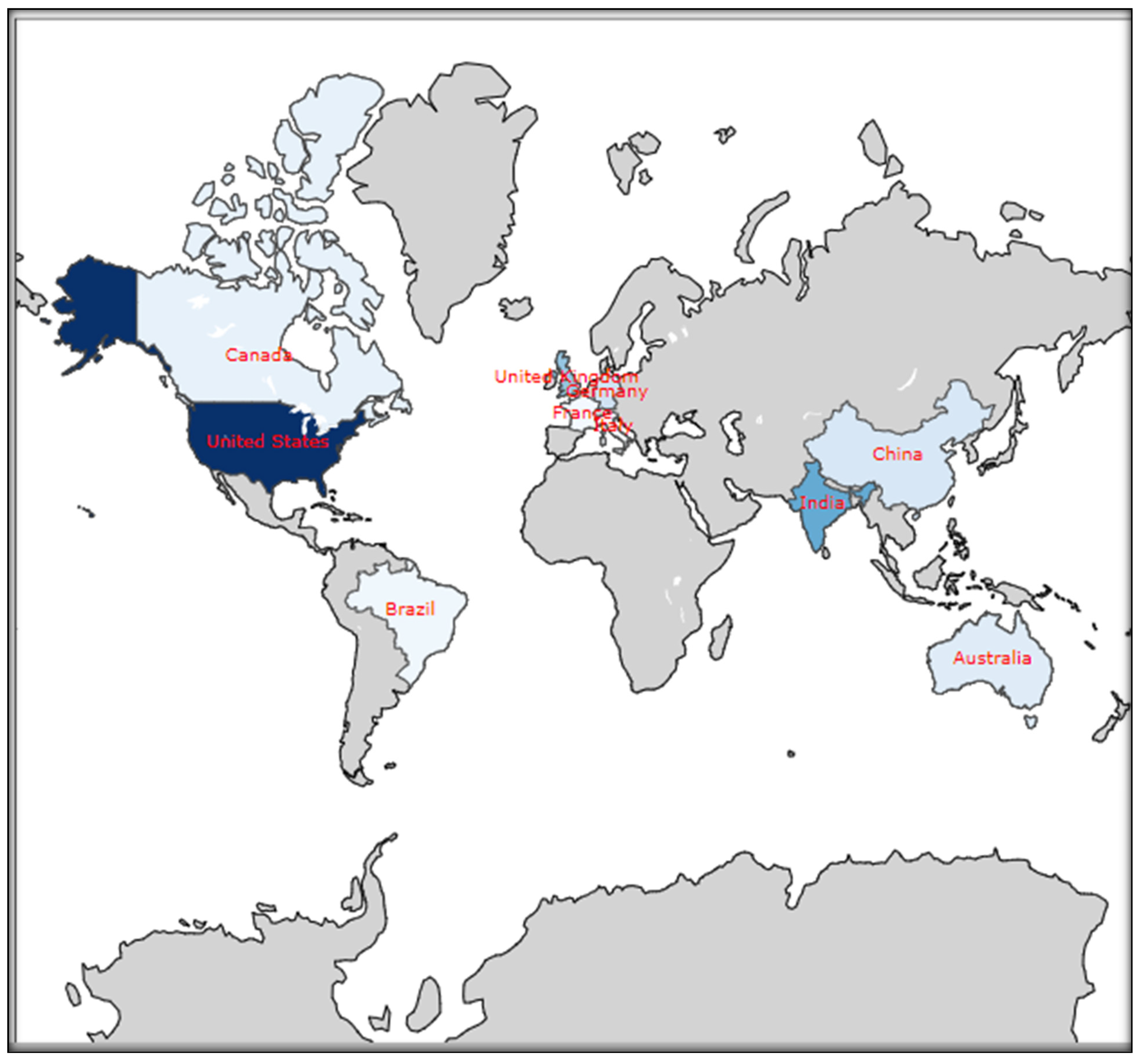


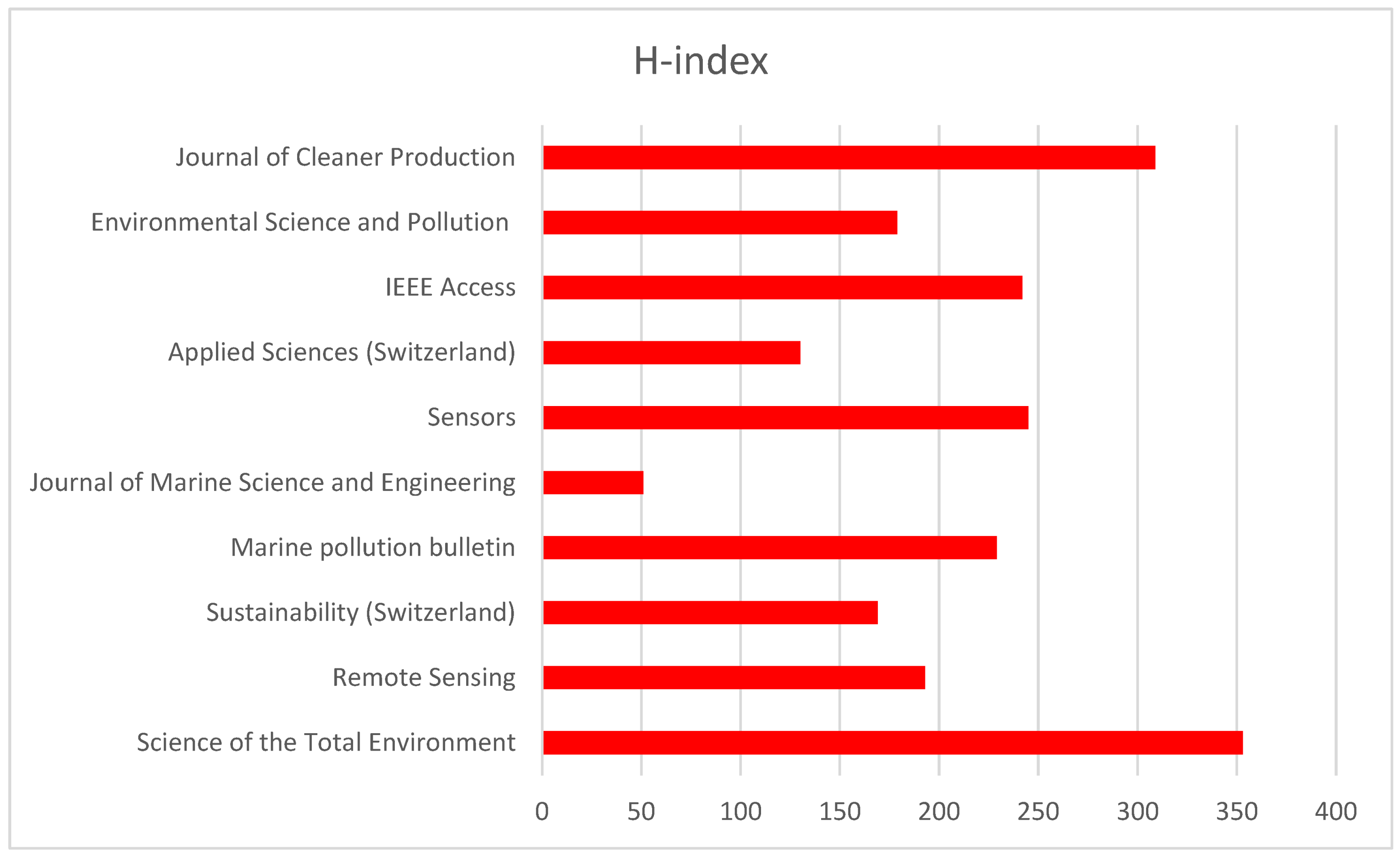
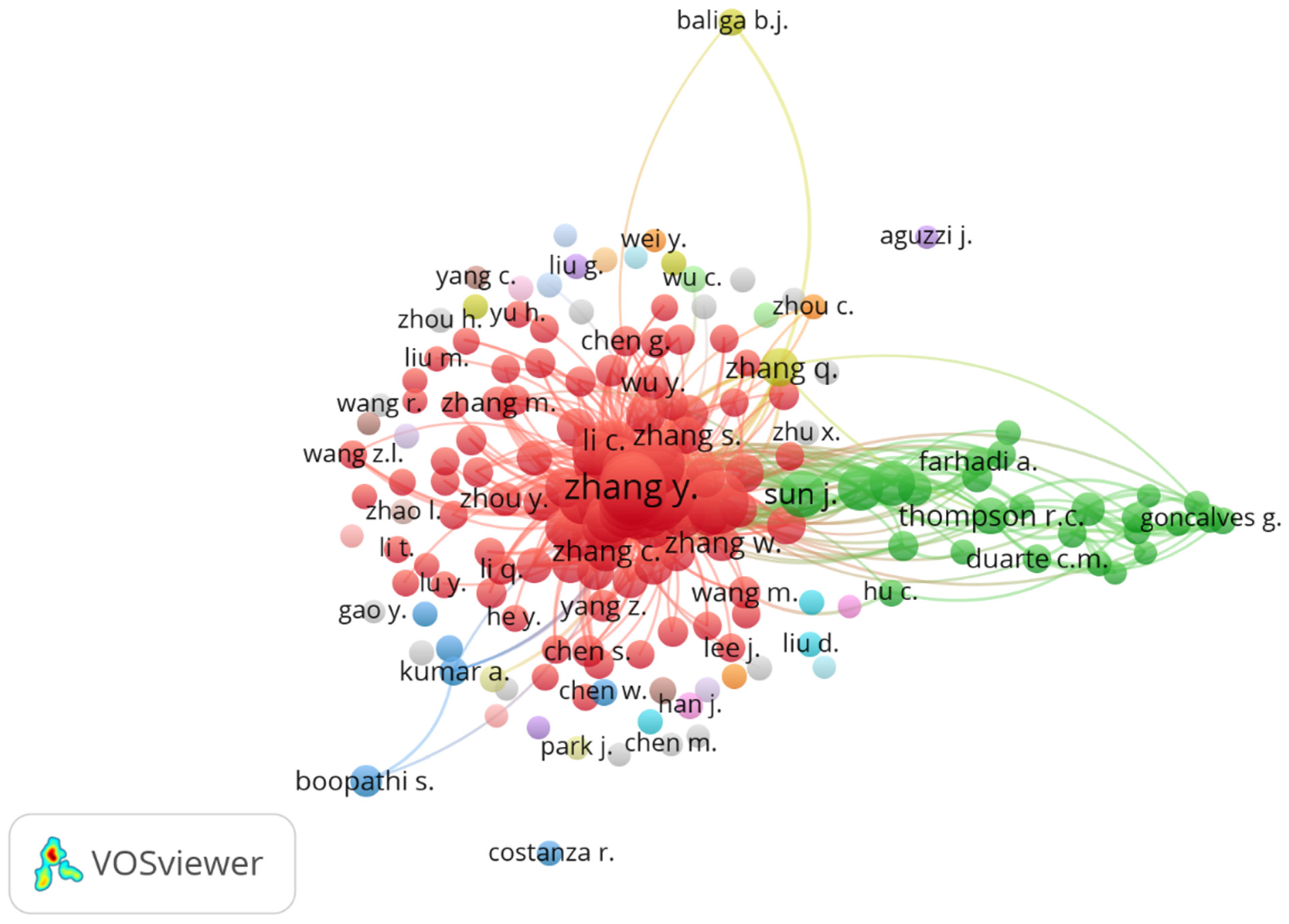
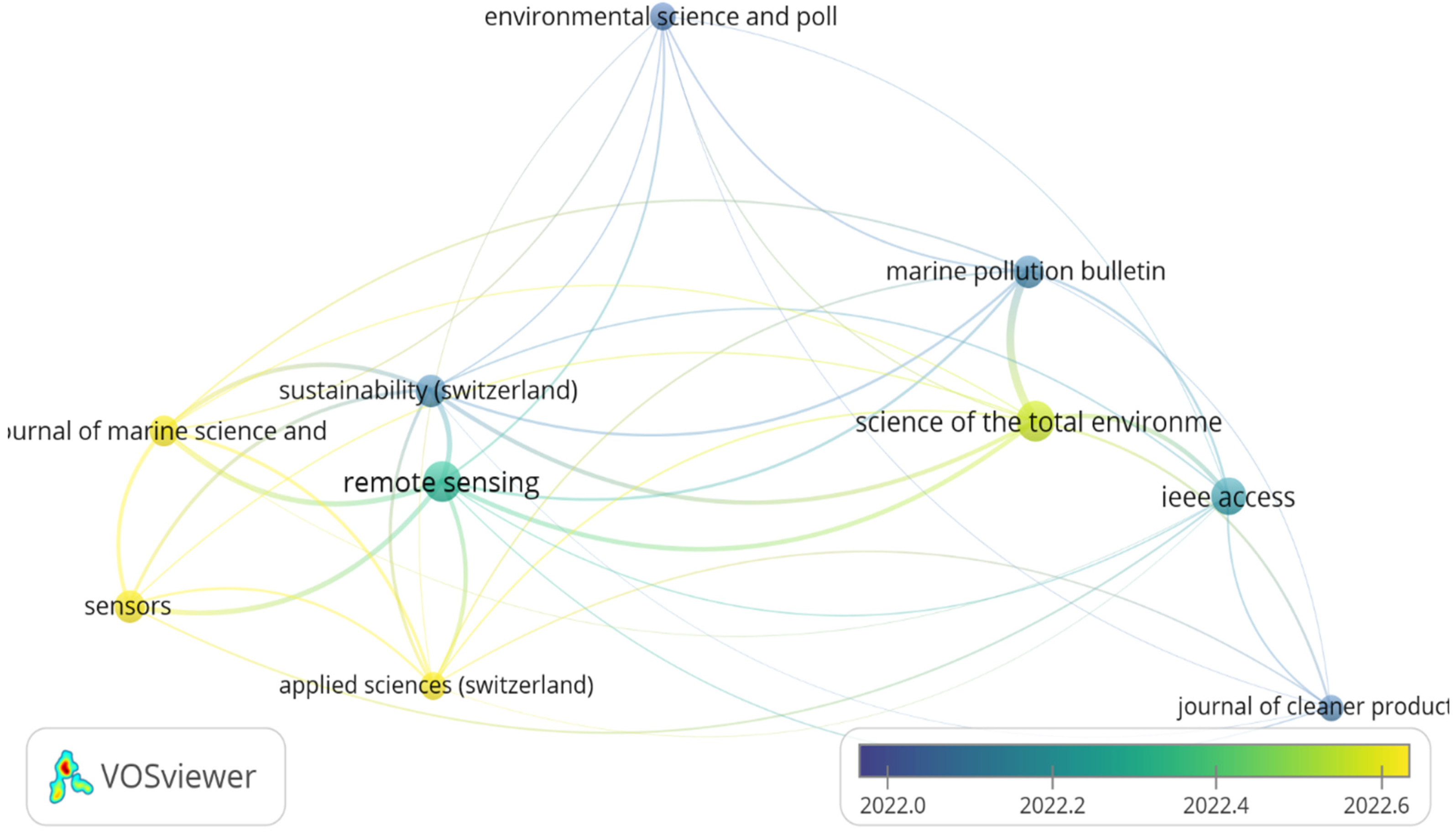
| S/N | Journals | Total |
|---|---|---|
| 1 | SENSORS | 703 |
| 2 | SUSTAINABILITY | 647 |
| 3 | IEEE ACCESS | 573 |
| 4 | INTERNATIONAL JOURNAL OF ENVIRONMENTAL RESEARCH AND PUBLIC HEALTH | 447 |
| 5 | SCIENCE OF THE TOTAL ENVIRONMENT | 310 |
| 6 | WATER | 279 |
| 7 | ELECTRONICS | 262 |
| 8 | REMOTE SENSING | 239 |
| 9 | ENVIRONMENT INTERNATIONAL | 171 |
| 10 | BRIEFINGS IN BIOINFORMATICS | 136 |
| 11 | ATMOSPHERE | 135 |
| 12 | FRONTIERS IN MARINE SCIENCE | 131 |
| 13 | ENVIRONMENTAL SCIENCE AND POLLUTION RESEARCH | 131 |
| 14 | TOXICS | 115 |
| 15 | FRONTIERS IN ENVIRONMENTAL SCIENCE | 113 |
| 16 | RENEWABLE & SUSTAINABLE ENERGY REVIEWS | 103 |
| 17 | ENVIRONMENTAL RESEARCH | 99 |
| 18 | ENVIRONMENTAL POLLUTION | 91 |
| 19 | ENVIRONMENTAL HEALTH PERSPECTIVES | 90 |
| 20 | ECOTOXICOLOGY AND ENVIRONMENTAL SAFETY | 84 |
| S/N | Keywords | Occurrences | Total Link Strength |
|---|---|---|---|
| 1 | Machine learning | 1673 | 4346 |
| 2 | Deep learning | 1099 | 2913 |
| 3 | Artificial intelligence | 691 | 2153 |
| 4 | Air pollution | 404 | 951 |
| 5 | Feature extraction | 151 | 743 |
| 6 | Pollution | 255 | 648 |
| 7 | Microplastics | 281 | 635 |
| 8 | Review | 177 | 614 |
| 9 | COVID-19 | 205 | 611 |
| 10 | Internet of Things | 151 | 565 |
| 11 | Climate change | 234 | 547 |
| 12 | Systematics | 75 | 529 |
| 13 | Computer vision | 171 | 520 |
| 14 | Sustainability | 207 | 487 |
| 15 | Systematic review | 201 | 480 |
| 16 | Remote sensing | 187 | 477 |
| 17 | Neural networks | 114 | 437 |
| 18 | Classification | 131 | 432 |
| 19 | Sensors | 103 | 394 |
| 20 | Task analysis | 59 | 393 |
| Source | Documents | Citations | Total Link Strength | H-Index | Publisher |
|---|---|---|---|---|---|
| Science of the Total Environment | 26 | 791 | 91.48 | 353 | Elsevier |
| Remote Sensing | 27 | 436 | 89.65 | 193 | MDPI |
| Sustainability (Switzerland) | 17 | 405 | 65.00 | 169 | MDPI |
| Marine Pollution Bulletin | 17 | 396 | 64.96 | 229 | Elsevier |
| Journal of Marine Science and Engineering | 15 | 75 | 53.50 | 51 | MDPI |
| Sensors | 18 | 362 | 43.50 | 245 | MDPI |
| Applied Sciences (Switzerland) | 12 | 130 | 38.00 | 130 | MDPI |
| IEEE Access | 22 | 633 | 26.71 | 242 | IEEE |
| Environmental Science and Pollution | 13 | 407 | 11.93 | 179 | Springer |
| Journal of Cleaner Production | 11 | 448 | 10.71 | 309 | Elsevier |
| Source | Documents | Citations |
|---|---|---|
| Journal of Cleaner Production | 11 | 448 |
| Journal of Environmental Management | 7 | 231 |
| Journal of Hazardous Materials | 9 | 100 |
| Journal of Marine Science and Engineering | 15 | 75 |
| Marine Pollution Bulletin | 17 | 396 |
| Ocean and Coastal Management | 6 | 57 |
| Ocean Engineering | 7 | 100 |
| Oceans Conference Record (IEEE) | 5 | 14 |
| Remote Sensing | 27 | 436 |
| Science of the Total Environment | 26 | 791 |
| Sensors | 18 | 362 |
| Sustainability (Switzerland) | 17 | 405 |
| Water (Switzerland) | 7 | 321 |
Disclaimer/Publisher’s Note: The statements, opinions and data contained in all publications are solely those of the individual author(s) and contributor(s) and not of MDPI and/or the editor(s). MDPI and/or the editor(s) disclaim responsibility for any injury to people or property resulting from any ideas, methods, instructions or products referred to in the content. |
© 2025 by the authors. Licensee MDPI, Basel, Switzerland. This article is an open access article distributed under the terms and conditions of the Creative Commons Attribution (CC BY) license (https://creativecommons.org/licenses/by/4.0/).
Share and Cite
Adeoba, M.I.; Pandelani, T.; Ngwangwa, H.; Masebe, T. The Role of Artificial Intelligence in Sustainable Ocean Waste Tracking and Management: A Bibliometric Analysis. Sustainability 2025, 17, 3912. https://doi.org/10.3390/su17093912
Adeoba MI, Pandelani T, Ngwangwa H, Masebe T. The Role of Artificial Intelligence in Sustainable Ocean Waste Tracking and Management: A Bibliometric Analysis. Sustainability. 2025; 17(9):3912. https://doi.org/10.3390/su17093912
Chicago/Turabian StyleAdeoba, Mariam I., Thanyani Pandelani, Harry Ngwangwa, and Tracy Masebe. 2025. "The Role of Artificial Intelligence in Sustainable Ocean Waste Tracking and Management: A Bibliometric Analysis" Sustainability 17, no. 9: 3912. https://doi.org/10.3390/su17093912
APA StyleAdeoba, M. I., Pandelani, T., Ngwangwa, H., & Masebe, T. (2025). The Role of Artificial Intelligence in Sustainable Ocean Waste Tracking and Management: A Bibliometric Analysis. Sustainability, 17(9), 3912. https://doi.org/10.3390/su17093912


_Li.png)




